The Wargame Before the War: Russia Attacks Ukraine
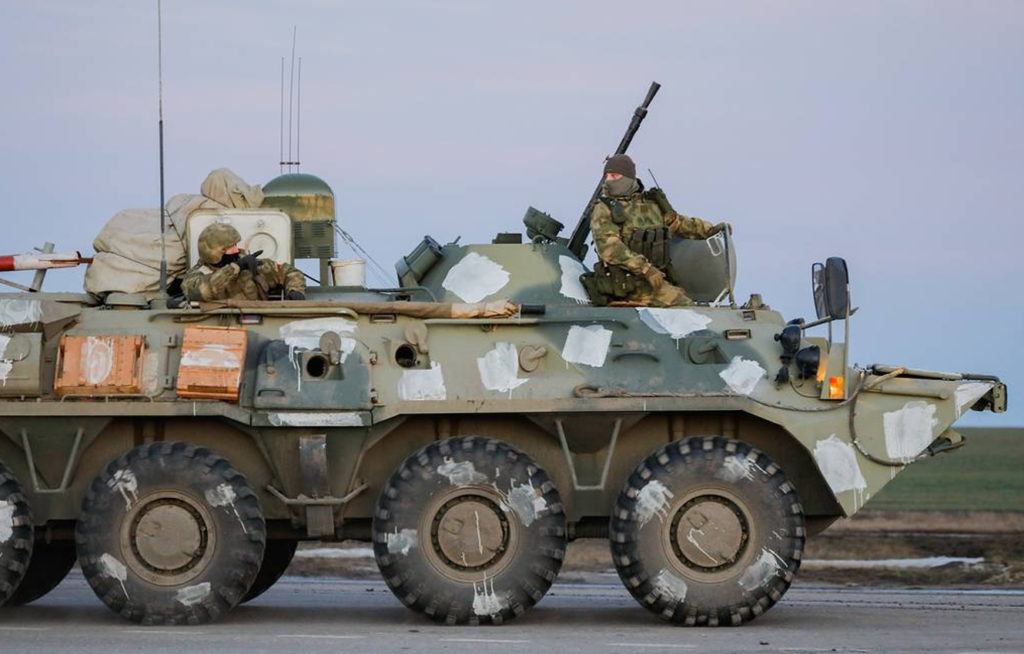
Editor’s note: Don’t miss our comprehensive guide to Russia’s war against Ukraine.
In the two weeks prior to the Russian invasion of Ukraine, Marine Corps University ran a four-day wargame to simulate the first several days of just such an invasion. One of us ran the wargame while the others played the Ukrainian and Russian forces. Despite a few stark differences, the current Russian offensive is playing out in ways eerily similar to that simulation.
By the time the wargame ended, the overall situation appeared very much as it does on the ground in Ukraine, with only two major deviations. First, the Russians have pushed harder out of Belarus to the west of the Dneiper — north of Kyiv — to strike the city from the rear. And secondly, the Russian assault in Kherson was temporarily halted, as the axis of advance in the south for a time turned northeast toward Mariupol. Both of these actions were, however, discussed by the players in the wargame.
Another difference was in the impact of the Russian air and missile campaign. In the game, Russian operations began with a series of missile and airstrikes, aimed at eliminating Ukraine’s air force and destroying the country’s integrated air defense system. Thus, the Russian players’ primary focus, during the first few days of the campaign, was aimed at gaining freedom of maneuver in the skies — air dominance — along with destroying Ukraine’s coastal defense systems. So, although the number of actual strikes made by the Russians in the conflict’s first 24-hours tracked almost exactly to what was employed by the Russians in the wargame, the impact was substantially different. In the wargame, every strike was focused on eliminating Ukraine’s air force and air defense network. In real life, the Russian strikes appear to have been more widely spread over a range of targets. Thus, the Russians employed far fewer munitions than required to cripple Ukraine’s air defenses or to significantly degrade their ability to control forces in the field. In short, unlike in the game, the Russian attacks were damaging but insufficient to overwhelm Ukraine’s defenses.
Figure 1
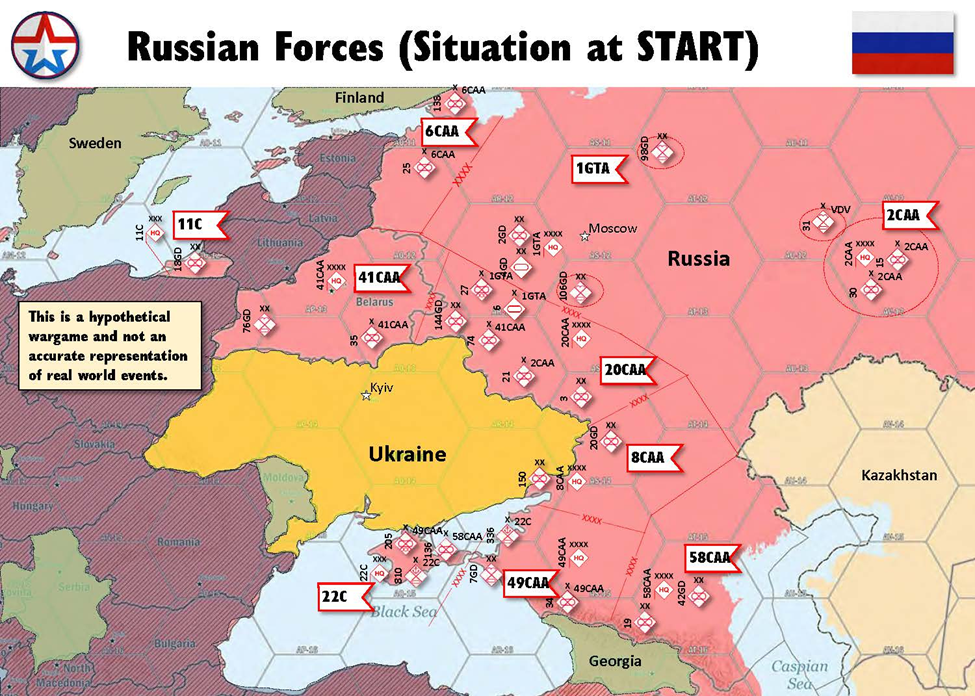
Much of the Ukrainian air force was destroyed on the ground as a result of Kalibr and Kh-101 cruise missile strikes, special operations-enabled targeting and direct action, and air strikes. The surviving remnants were overwhelmed and destroyed in the air, some being shot down by long-range air defense systems in Russia, with ranges extending into Ukrainian airspace. This stands in stark contrast to what Russia has achieved in its actual operations. Going into the fifth day of the war, Ukraine’s air defenses are still functioning, even if at a reduced level of effectiveness. Moreover, by all accounts, the Ukrainian air force remains in the fight, and in combination with the remaining air defenses is having some success in contesting Ukraine’s airspace. At present, the Russians appear to possess air superiority, but the reported 30+ sorties the Ukrainians are launching daily have denied the Russians the level of air dominance that they achieved in the wargame. Primary initial targets in the wargame were Ukrainian S-300 systems around Kyiv, the Dnieper River bend, Kherson, and Odessa. Secondary targets were Ukraine’s dozens of BUK (SA-17) systems. The damage done to Ukraine’s air defense system was extensive, neutralizing the core integrated air defense network in the first two days, although the dispersion of Ukraine’s BUK systems assured a residual anti-air capability. Moreover, at the cost of 30 to 40 aircraft, in the wargame, the Russians gained air dominance, as the Ukrainian air force was virtually wiped out by day three of the wargame. There were likely some residual survivors, but Ukraine’s ability to operate at the squadron level was neutralized.
In the wargame, the main Russian ground offensive was purposely delayed, as the Russian players focused on several days of shaping fires aimed at destroying critical enemy capabilities before committing the bulk of their ground forces. Russia’s plan was to conduct an even longer period of shaping, but the game was time-limited, forcing the players to begin ground operations earlier than they wished. Still, the impact of the wargame’s shaping fires was profound, as once the ground forces advanced, they had strong support from Russian airpower, now flying in uncontested skies. At this time, the Russian fires complex (artillery, air, and missiles) switched its priority to destroying Ukrainian fire support systems.
Much of this is what one would expect based on what we know about the Russian way of war. But the game differed in several major aspects from what most analysts expected prior to the war. First, the amount of fires employed in the wargame was only a fraction of what the Russians had available. Also, at the start of the campaign, the Russians avoided striking at the four regional Ukrainian command and control headquarters, in order to allow them to communicate their surrender if the government collapsed. Consequently, throughout the wargame, these headquarters remained functional and effective, as the Russians focused much of their available long-range strikes on gaining air dominance. These headquarters were just starting to come under intense pressure when the game ended.
In diverging from Western interpretations of the Russian way of war, the wargame closely mimicked what we mostly saw in the first few days of Russia’s actual military operations. Russia’s apparent reticence to bury Ukraine’s military under a blanket of fire has surprised many Western observers. But it was almost the precise course of action the Russians undertook in the wargame. The only difference was that in the wargame these strikes were focused on eliminating Ukraine’s air force and air defense network, whereas the actual distribution of Russian strikes has been more varied. Also, in the game, the air and missile strikes took place before the ground offensive began, whereas in real life the Russians appear to have forgone a strike phase of operations in favor of launching their strike campaign simultaneously with the ground offensive. But as the conflict continues and Russian frustrations grow over their failure to rapidly collapse Ukrainian resistance, one can expect the Russians to revert to type and start employing their overwhelming superiority in artillery and airpower much more indiscriminately. In fact, news reports indicate that is already happening.
Figure 2
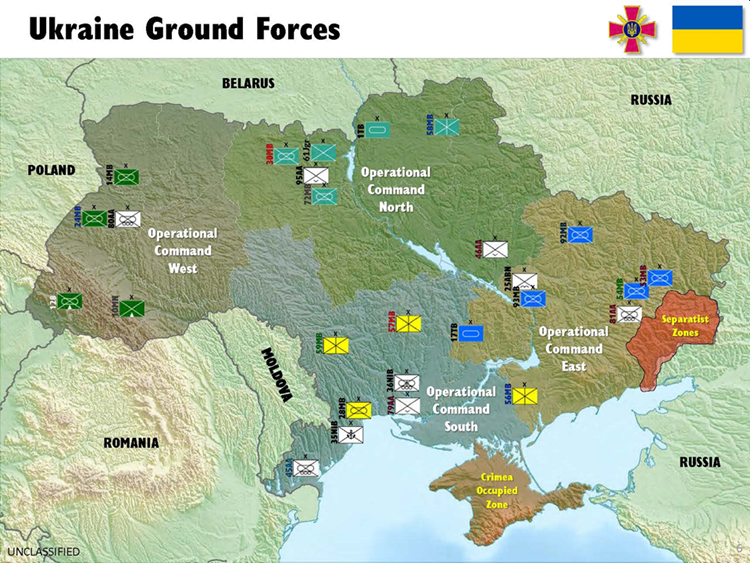
The map above shows the prewar garrison positions of Ukraine’s land forces. As the Ukrainian government made a political calculation not to mobilize or move units into defensive positions, this map likely represents where most Ukrainian military formations started the war. The crucial early decision for Ukraine was what to do with the 17 to 20 battalions arrayed on the line of control in the Donbas area. Realizing that these forces were at high risk of envelopment and could not withstand an all-out assault by Russia’s 8th Combined Arms Army, the decision was made to withdraw to the Dnieper River, with the exception of the Ukrainian 92nd Mechanized Brigade plus parts of the 53rd and 54th Mechanized Brigades, which were sent to consolidate positions in and around Kharkiv.
The intent of these orders was to lure Russia’s 8th Combined Arms Army into expending vast amounts of resources hitting empty positions, as the Ukrainians would have already fallen back to the Dnieper River. At the same time, the Ukrainian team hoped to make Kharkiv a second Stalingrad, which would suck ever-increasing numbers of Russian forces into a bloody attritional fight. In the game, moving away from the line of control proved difficult, as retreats under pressure always are. At least six Ukrainian battalions were overrun, and the remainder endured serious losses to aerial interdiction en route to the Dnieper. In the actual conflict, there are recent reports of Ukrainian units moving off these lines suffering large losses, as the wargame predicted. Still, the retreat was necessary in the wargame to ensure those forces were not encircled from the north and by forces moving out of Crimea. These same concerns appear to be driving the Ukrainians in the real fight.
The wargame also generated substantial discussion of what to do with the five brigades Ukraine has in the western part of the country. Some of that force was moved north to the Belarussian border in case of a secondary Russian assault out of western Belarus, but most of it was ordered east to help defend Kyiv and to bolster the Dnieper defense. At present, there is very little public discussion of how the Ukrainians are actually employing these forces.
In the wargame, the Russian 1st Guards Tank Army attacked on an axis aimed at the Dnieper River bend, intent on bypassing Kharkiv to the north while the 20th Combined Arms Army approached the outskirts of Kharkiv. This appears to be exactly what the Russian forces have been attempting in the first 96-hours of the war. Once again, the wargame matched actual Russian moves with uncanny accuracy.
The Ukrainian commander, in the wargame, decided to send three brigades from the city to counterattack into the flank of Russian armored forces. This led to a major engagement about 40 kilometers northwest of Kharkiv against the Russian 27th Guards Separate Motorized Rifle Brigade. In the ensuing battle, both the 27th SMRB and the Ukrainian 92nd Mechanized Brigade were destroyed. A post game analysis decided that it would have been better to keep the Ukrainian force in the city per the original plan and turn Kharkiv into a fortress city. If the Russians bypassed the city, the Ukrainians could have looked for counterattack opportunities after Russia’s leading combat formations had gone past. If they attacked the city in force with the 20th Combined Arms Army, the Ukrainians could have turned it into another Stalingrad. In real life, the Ukrainians appear to have opted to do as our after-action analysis tells us was the best course of action, and Kharkiv continues to hold out against increasingly ferocious Russian assaults.
Figure 3: Wargame Situation — End of Game Day 3 — Eastern Front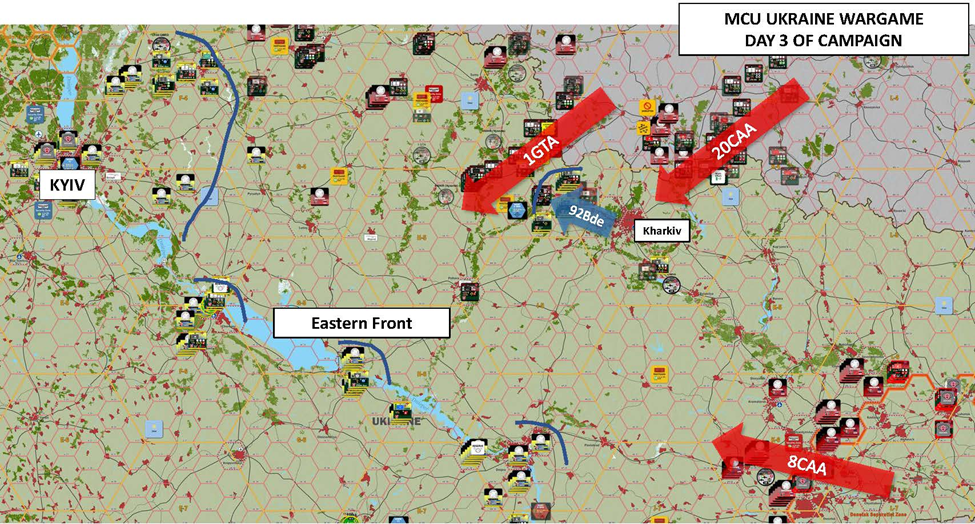
In the wargame, the Ukraine team screened the bottleneck to the north of the Crimean Peninsula but could not contain a powerful Russian attack that pushed through and advanced on Kherson. On the third day of the wargame, the Russians launched a combined ground, air, and amphibious assault on the Ukrainian defenses around Kherson — accelerated in execution due to the short time available to play the game. There are just two bridges on the southern sector of the Dnieper River which are key terrain. Both were targets of the Russian ground and air assault, as a separate combined air and amphibious assault landed on the west side of the Dnieper to envelop Ukrainian defensive positions along the river line. At the time the game ended, this major ground fight all along the river in the vicinity of Kherson and along the shores of the Black Sea just to the south and west of Kherson was still developing.
In the game the Russian advance out of the Crimea was their most rapid and successful operation. When the game ended, the Russians were poised to strike in one or more of three directions — west to Odessa, east to envelop the Ukrainians retreat out of the defensive lines along the separatist regions, or north to dislocate the Ukraine’s defense of the Dnieper line. On the fifth day of the war, we find a similar situation, with the Russian forces having flowed out of the Crimea into close to the same positions they occupied in the wargame, and with the same choices before them as we found in the wargame.
Figure 4: Wargame Situation — End of Game Day 3 — Southern Front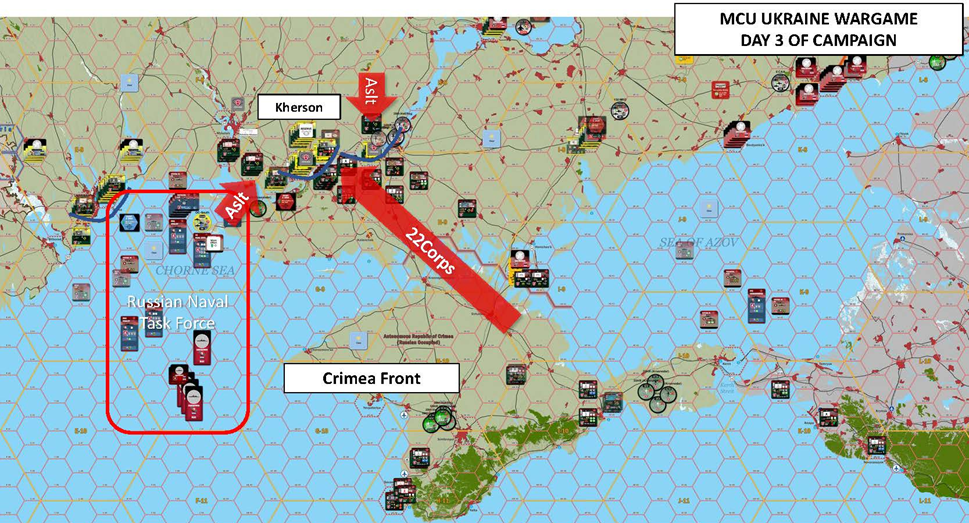
In the north, a Ukrainian brigade conducted a spoiling attack against Russian forces across the border in Belarus. This was a controversial move that achieved limited tactical results. These Ukrainian forces were soon cut off as the Russian 41st Combined Arms Army attacked south into Ukraine on both sides of the Dnieper River at the same time. When the game ended, Ukraine’s forces in the north were under heavy pressure (see map below) but aside from one brigade were largely unengaged and remained astride the approaches to Kyiv. The defenses north of Kyiv had not broken and if supported they may have held for a considerable period.
Figure 5: Wargame Situation — End of Game Day 3 — Northern Front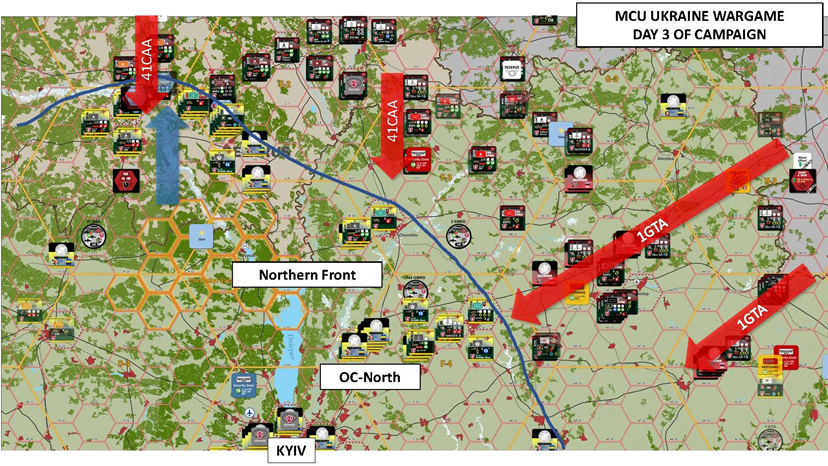
As the wargame ended, the Ukrainians were under pressure in the north, with Russian forces closing in on the eastern approaches to Kyiv and the Dnieper River, while also beginning to cross the border from Belarus into the northwest through the Chernobyl Exclusion Zone. In the east, the Russians were starting to encircle Kharkiv and the 8th Combined Arms Army was emerging from the Donetsk area to attack towards Melitopol and the Dnieper River. Again, this is almost precisely what we are seeing on the ground in Ukraine on the war’s fifth day.
Figure 6
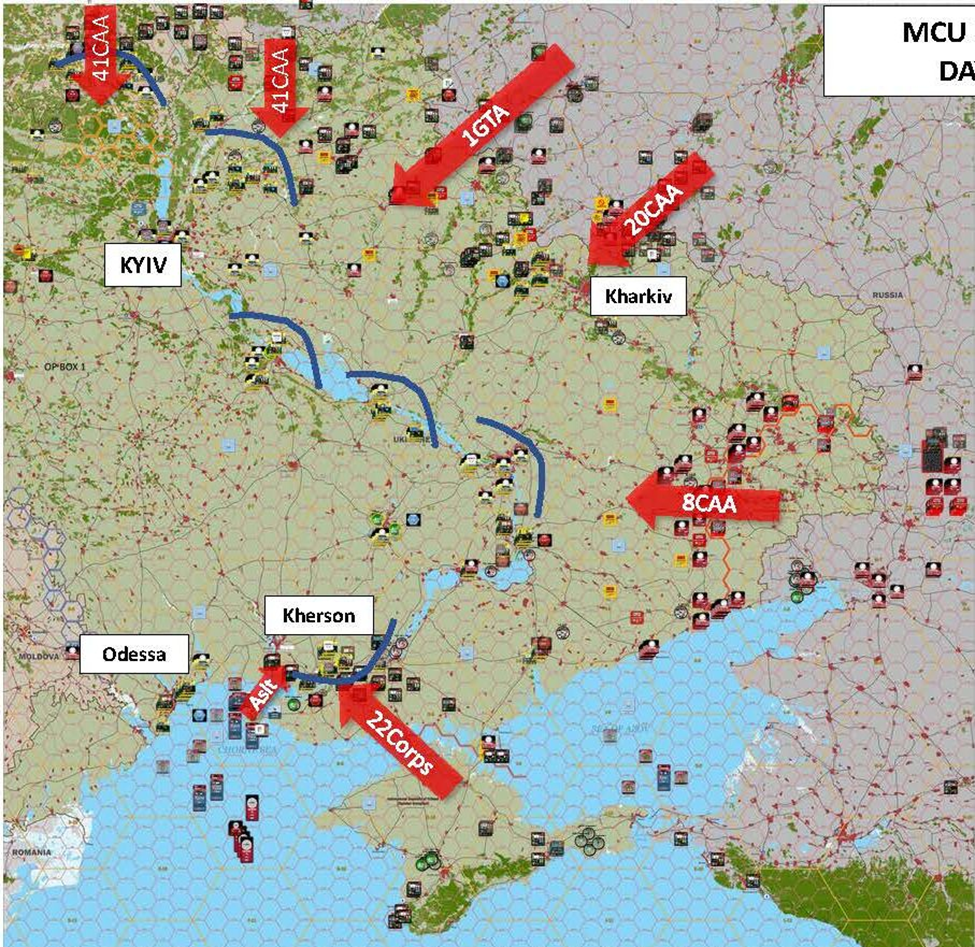
In the actual conflict, Russia’s attempt at a rapid move to Kyiv aiming to decapitate the government appears to have backfired. While many observers were surprised by the Russian approach, it was the course of action chosen by the Russian player in the game. Moreover, when the Ukrainians failed to roll over and surrender the Russians are increasingly opting for their preferred firepower-heavy method of warfare. Ukraine’s ability to score some early wins and demonstrate incredible acts of courage from President Volodymyr Zelenskyy on down have generated an inspired defense, similar to Ukraine’s course in the wargame. While the wargame did not simulate the strategic level of warfare, the international support garnered by Ukraine’s heroic resistance may, in the end, prove fatal to Russia achieving its aims.
One wonders if the Russian failure to employ their massive fires capacity to deliberately shape the battlefield over an extended period before the ground advance began will be marked by historians as a blunder. In the wargame, this constraint on fires was deliberate, based upon a strategy to compel a rapid Ukrainian surrender. An excellent case can be made that the Russians made similar calculations at the start of the current war. Putin, and those advisers who still have his ear, may have been convinced many Ukrainians would welcome them as liberators and the march to Kyiv would be an easy one. Thus, they have held back much of their overwhelming fires complex to avoid destroying significant amounts of infrastructure and killing too many of their Ukrainian “brothers.” This was the reasoning employed in the game, and most current reporting shows it was the thinking dominating the Kremlin.
It must now be dawning upon senior commanders and possibly even Putin that they have grossly miscalculated, and are now in violation of Clausewitz’s most important dictum: “The first, the supreme, the most far reaching act of judgement that the statesman and a commander have to make is to establish … the kind of war on which they are embarking; neither mistaking it for, nor trying to turn it into, something that is alien to its nature. This is the first of all strategic questions and the most comprehensive.” What Ukraine must figure out now is Russia’s likely next moves, as Putin concludes that his invasion is not going to be a modern day Anschluss.
Russia must also now be considering next steps. The Ukrainian military and people are putting up much stouter resistance than Putin or any of his senior-most commanders anticipated. This situation is worsened by something becoming more apparent by the day; the Russian military’s capacity to conduct a vast joint and combined arms assault may not be quite as good as advertised. Ukrainian resistance is not yet at the point where one can make comparisons to Finland’s courageous stand against Stalin’s Red Army in the 1940 Winter War, but the possibility of Ukraine holding out for weeks or months must now be part of everyone’s calculations, including the Russians.
That Zelenskyy remains capable of talking to his commanders and the outside world is encouraging and clearly has provided a strategic level boost in the information war and in Ukrainian morale. By still being able to communicate to the outside world, Zelenskyy has single-handedly changed the strategic balance rallied Western support beyond what anyone could have foreseen, to include anti-tank weapon support from both Germany and Sweden.
During the wargame, there was a lot of discussion about the employment of information weapons, including cyber. It is therefore noteworthy that aside from Anonymous’ declaring cyber war on Russia, there is very little public reporting of actual cyberattacks by either side. Prior to the conflict one of the West’s great concerns was Russia’s much-vaunted cyber capabilities. So, either the Russians are holding a number of zero-day exploits in reserve, or it is time to closely examine how dangerous cyber operations truly are. Moreover, for all the heated talk about hybrid and grey zone warfare, this is a fight of blood and iron, in which Otto von Bismarck would have felt at home, something wargames are spectacularly good at simulating.
Still, even if one accepts that the Russians are trying to limit Ukrainian casualties and infrastructure damage, it is difficult to ignore the fact the Russians have been slow off the mark. Once the Russian offensive began to roll there was a wide expectation of a rapid armored descent on Ukraine’s key cities — Kyiv, Kharkiv, Dnipro, and Odessa. At present, none of these cities have fallen, and the Russian ground offensive appears to be slowing, as it faces stiffening resistance and logistic challenges. It may turn out the Russian advance was slowed due to political directives, but, at the moment, many observers can fairly attribute much of what is being reported from the battlefield to general Russian incompetence.
Only in the south have we seen the Russians making the kind of rapid advances that were expected to take place throughout Ukraine. The Russians attacking out of the Crimea are already advancing on Mykolaiv, a distance of approximately 150 miles from their line of departure in Crimea. Other Russians forces appear to have captured the key town of Melitopol, and are advancing on the port of Berdyansk and Mariupol. On the other side of the ledger, Ukrainian forces have counterattacked and retaken Kherson. Also, as of yet, the Russians have not forced the Dnieper in the south, and the forces in the east, pushing forward north of Kharkiv, are still some distances from the Dnieper crossings. Only to the north of Kyiv have the Russians made dangerous gains. But as this is being written, even here the Russian initial advances toward Kyiv appear to have been stymied some miles north of the city.
The Value of Wargaming
Our Ukraine wargame is part of a series of operational level wargames designed by Marine Corps University to support professional military education and help students develop an understanding of the many operational challenges associated with all domain warfare and Great Power conflict. The hope is that students will develop insights from these wargames that help them better understand joint warfighting. In the case of this particular wargame, its near concurrent use with the actual start of the war presents an opportunity to make constructive comparisons and contrasts. Actual events also highlight the importance of the human domain and how difficult it is to effectively model or assess prior to conflict. While the game does make allowance for aspects of the human domain, it is hard to factor in things like the courageous leadership being demonstrated by Zelenskyy and its impact on the will of the fighting forces and the Ukrainian people.
One must be very careful when using a wargame for predictive purposes. But, on the other hand, no one involved in this wargame has been much surprised by anything unfolding on the ground. Almost all of it took place within the game or was discussed at length among the players. This is in contrast with nearly every expert and pundit on the airwaves, who are expressing astonishment at how this conflict is unfolding. If this wargame had been played at the Pentagon or the White House in the weeks leading up to the war, no strategist or policymaker would be shocked by any event so far seen in the war.
The heroic resistance of the Ukrainians inspires awe and admiration. Still, their forces are greatly outnumbered, particularly in the air. Moreover, Russia’s capacity to concentrate vast ground fires — artillery, rockets, and missiles — still allows the Russian army to overwhelm the Ukrainians at any chosen point. If history provides any glimpse into the future, the Russian army will eventually uncoil, absorb the war’s early lessons, and renew its advance with grim determination. Russia was preparing to do precisely that when the wargame ended. Still, one hopes that Western pressure, and the infliction of unacceptable losses upon Putin’s legions will create an opening for a negotiated peace.
James Lacey, Ph.D., holds the Horner Chair of War Studies at Marine Corps University.
Tim Barrick is a retired Marine Corps colonel and the director of wargaming at Marine Corps University.
Nathan Barrick, Ph.D., a strategist at US Special Operations Command, is currently a student at the Marine Corps War College and a former U.S. Army Russian foreign area officer.
The views expressed in this article are the authors’ own and do not express the views or positions of Marine Corps University, the U.S. Marine Corps, the Department of Defense, or any part of the U.S. government.
Image: TASS (Photo by Anton Vergun)

